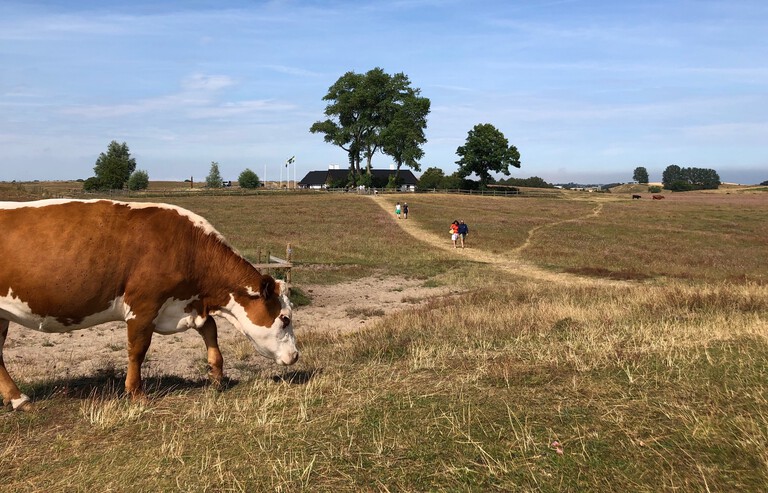
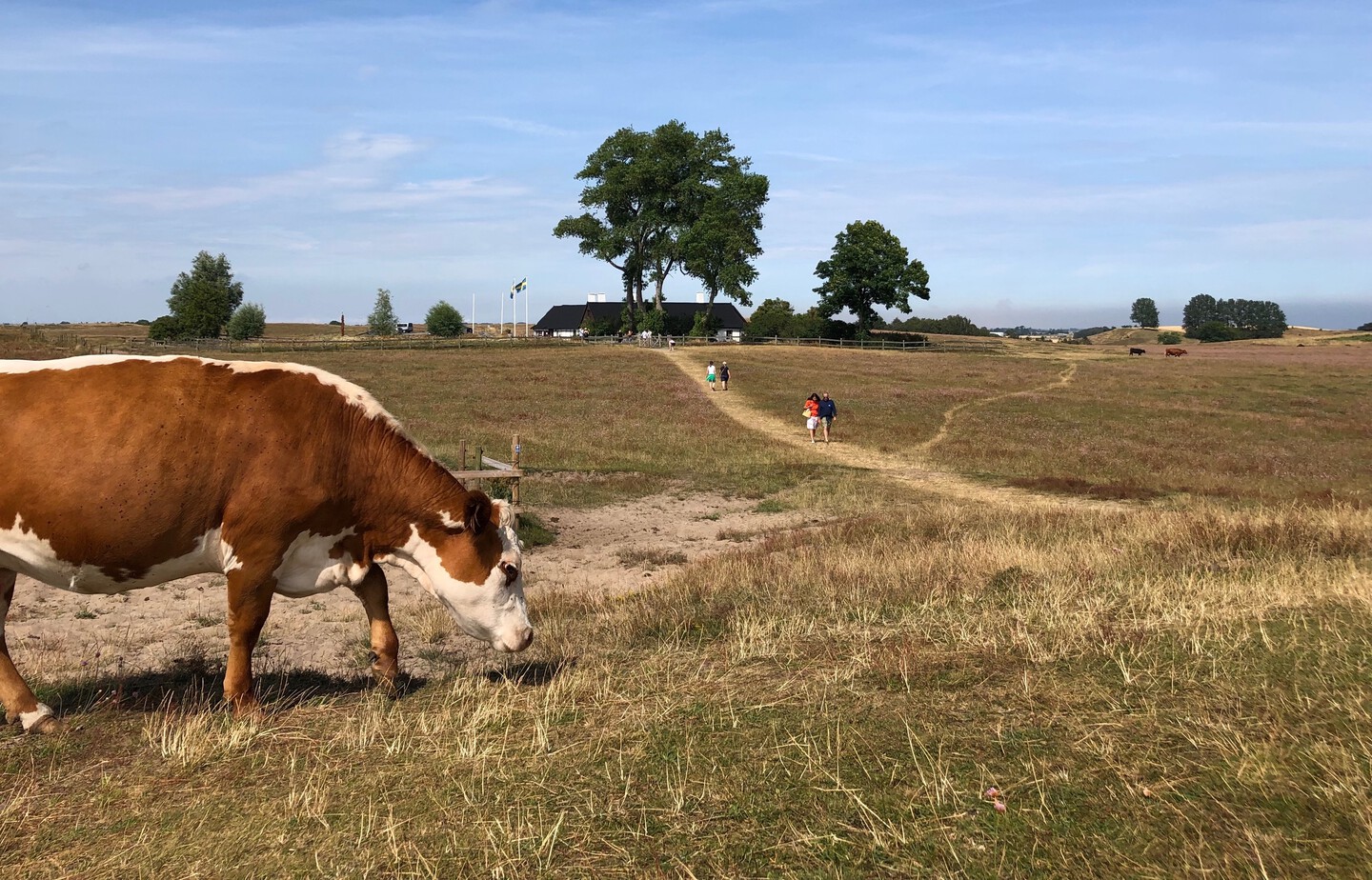
The Flowers
"A longing ... returned by the whispers of the trees, the fragrance of the soil, the caresses of the wind, the embrace of water and light."
Så vilar himlen mot jorden, the song played from the stereo. So rests the sky against the earth.
From the windows of my rental car, I saw the coastal wind caressing the yellow fields.
It was late summer, and the crops had already begun to bow towards the earth. Further towards the horizon, light, scattered clouds travelled over the dunes that rose like a gentle bulwark against the Baltic Sea.
I was driving down to Österlen, a sun-lit corner in the south-east of Sweden. Between the coastal road and the dunes, a few cottages dotted the landscape, hiding among pastures and patches of forest that breathed a resinous fragrance into the balmy morning air of late July.
It was the last stretch of my journey, and from the stereo was playing a recent tune that was a tribute to the poet was playing at whose summer house I was about to arrive, almost six decades after his death.
In the rearview mirror of time, the journey that was taking me down this country road had begun two decades earlier.
One of my teachers at elementary school was married to a pastor. As a young boy, I was fascinated by the set of white preaching bands he carried in his black prayer book. In my childish fantasy, they were the equivalent of a Superman’s cape – at a moment’s notice, he could transform from a mild-mannered layman into a pastor, able to perform spontaneous weddings in a single bound.
Our paths crossed again many years later, when I sought his counsel during a family crisis. Though I had by then outgrown my childhood notions of pastoral super-heroics, he was a friend of my parents and I thought he might have some insights that could help me navigate the situation.
“There are two books I read every year,” he mentioned to me on one of these occasions. “Marc Aurel’s Meditations and the Markings by Dag Hammarskjöld.”
At the time it was the Roman Emperor rather than the Swedish diplomat that impressed me.
Now, on the front seat of my rental car, the dog-eared pages of Markings, its margins full of notes, were fluttering in the wind.
My first glimpse of the summer house was from the parking lot, a black roof stretching over the whitewashed walls of a former barn.
Gravel crunched under my shoes as I walked down the narrow lane, the steps blending in with the occasional moo from the fields.
Behind a wooden fence, a few cows were grazing, not even remotely impressed by an early-morning passerby. Spots of purple blossoms sparkled in their dry pasture. From the middle of the field rose the cross of a maypole.
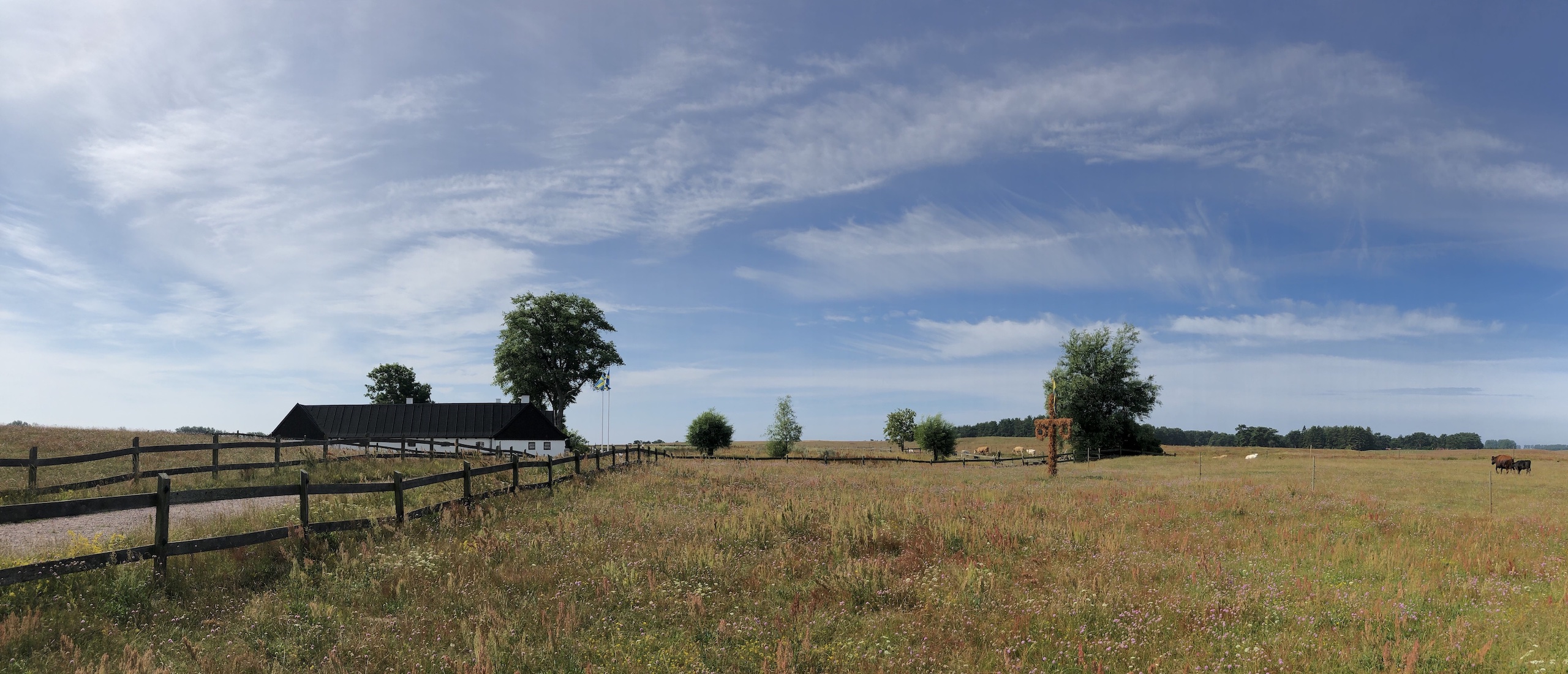
A few weeks ago, the country had celebrated the longest day of the year with a night of singing and dancing and the picking of seven flowers that, according to tradition, let you dream of your future love.
Things had been less bacchanalian here than in the rest of Scandinavia, I assumed. Yet, here too, wilting wreaths and a blue and yellow pennant draped over the withered leaves were evidence of the recent festival. An occasional breeze rustled the brittle garlands, spreading the earthy smell of the dry pasture.
It was a scene that brought to my mind lines by the poet-diplomat in front of whose estate I now stood:
Seven weeks have gone by
Seven kinds of blossoms
Have been picked or mowed.
Now the leaves of the Indian corn grow broad
And its cobs make much of themselves,
Waxing fat and fertile.
DAG HAMMARSKJÖLD, Markings, 6 August 1961
In 1957, Dag Hammarskjöld acquired the estate of Backåkra. It was the year he was appointed to his second term as Secretary-General of the United Nations.
For a while I lingered in front of the black door that led into the former farmhouse, listening to the leaves in the crown of a nearby oak. Steel cables clanged against the two flagpoles bearing the Swedish flag, reminiscent of the sound of the wind playing among the masts of moored ships.
A short walk further down the path, through a coastal forest and across the pastures, the sandy beaches of Sandhammaren line the shore. The Baltic line is a black line on the horizon.
During his time at the UN, this stretch of land became Hammarskjöld’s place of retreat, a place to ease the longings expressed in his writings for the whispers of the trees, the fragrance of the soil, the caresses of the wind, the embrace of water and light.
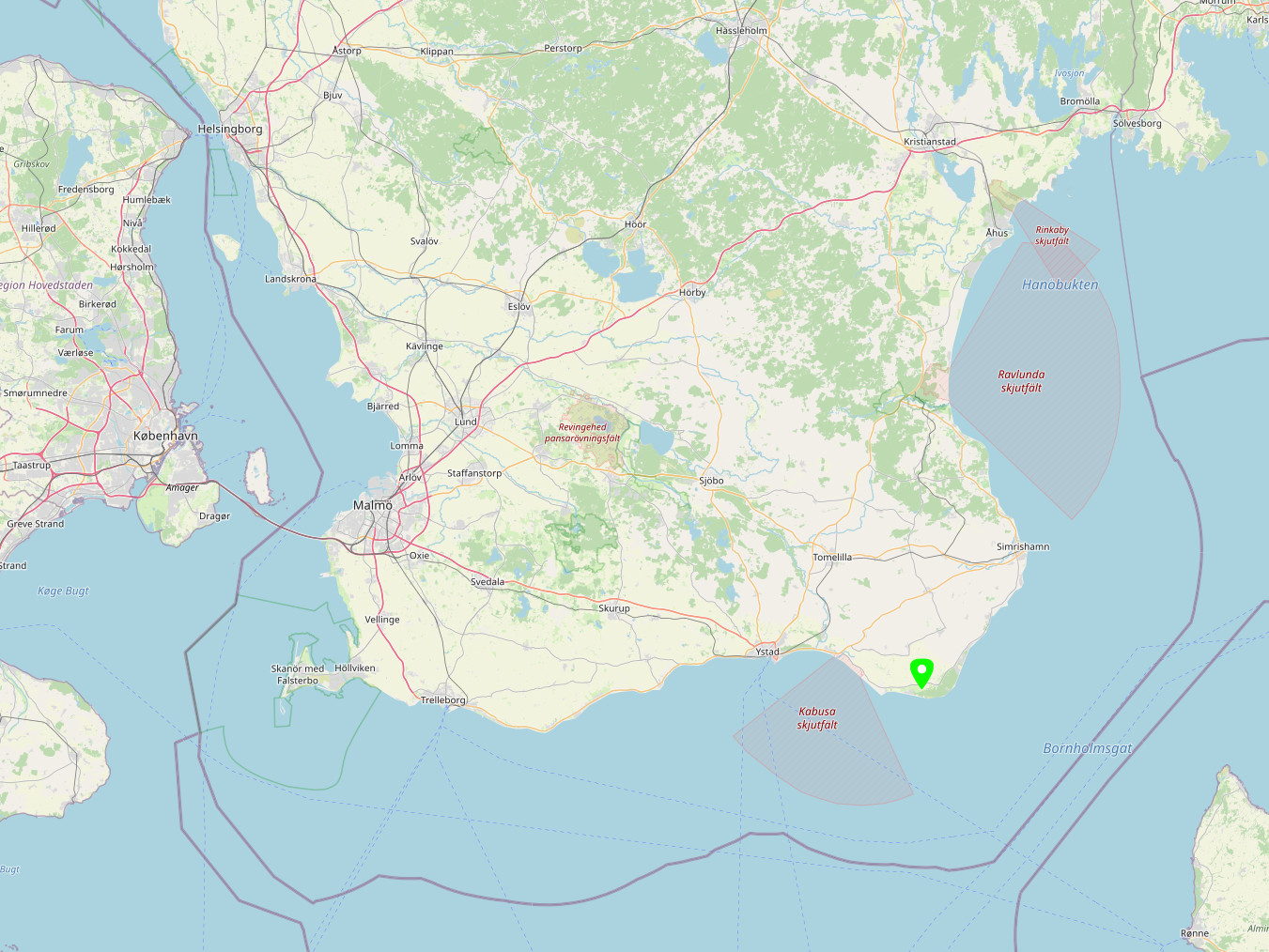
In the 1960s, Hammarskjöld’s retreat was turned into a museum dedicated to his memory. After substantial renovations, Backåkra had recently re-opened to the public again. Over the past weeks, I had been corresponding with Karin, the museum’s curator.
More than seven hundred objects that belonged to Hammarskjöld are preserved behind the doors of massive oak. One of them in particular had brought me to this far-flung corner of Sweden: the ice axe in the first photograph ever taken atop Mount Everest.
So that you may climb to even greater height, Sherpa Tenzing Norgay had had engraved on the shaft of the axe, which he presented to Hammarskjöld in Geneva, a year after the ascent.
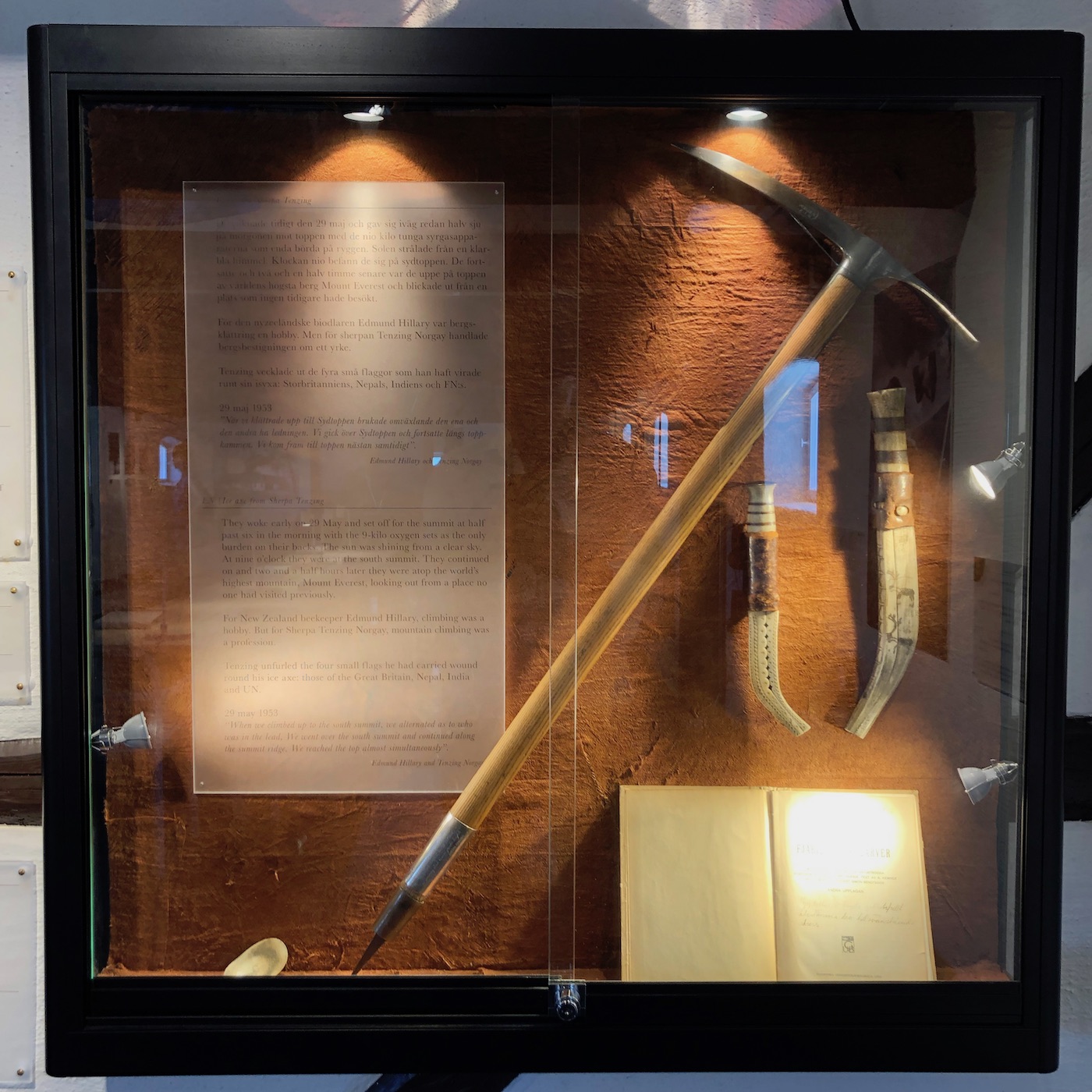
I had come to Backåkra to further research the story of the axe. Yet there was much more to be discovered, as I was soon to learn.
Several of the rooms are a re-creation of Hammarskjöld’s Upper East Side apartment, where he had lived for eight years during his tenure as UN Secretary-General. The furniture is arranged identically to the original apartment, as are the books on the shelves.
As a reader and writer, Hammarskjöld was deeply interested in all sorts of literature, but poetry in particular. Thus, an extensive private library had followed him from Sweden to his diplomatic post in New York.
Today, Backåkra preserves over 1500 books, with a similar number kept at the Royal Library in Stockholm. Upon my arrival, Karin showed me the index for the local collection.
Studying this fingerprint of Hammarskjöld’s intellectual interests, I began to look forward to the rest of the day, when I would be free to lose myself in his collection of books.
First, however, I followed Karin on a tour through Hammarskjöld’s study.
We passed along a wide table, where desk lamps provided light for reading copies of books about the Secretary-General’s life. Even a year after the re-opening, the wood still smelled fresh.
For Swedes of an older generation, the man whom Kennedy called ‘the most important statesman of the twentieth century’ is still the most visible example of their nation’s ideals. Today, however, many of the younger generation don’t recall Hammarskjöld’s name, and they see the UN as a bureaucratic behemoth no longer capable of living up to its agenda and mission.
The UN’s blue-and-white flag hung from the open loft above the table,. Interviews and original footage from Hammarskjöld’s two terms at the institution flickered over flat screens on the walls below.
In passing by I caught fragments of his voice, emanating from the headphones hanging on the wall. Sweden continued to shine through the color of his vowels and the melody underneath the diplomatic English in which he defied Khrushchev’s demands to resign.
Then, at the end of the long hall, I passed the glass display case with Norgay’s axe. My eyes caught the glimmer of light reflecting off the engraved silver hull around the shaft.
In the next room, two windows flooded the study with the light of Swedish summers. A wooden object with a concave surface stood beside the door.
“The staff had no idea what this thing is that was so complicated to hoover around,” Karin explained. “That was until Kofi Annan visited in 1999,” she smiled. “The Secretary-General was somewhat surprised to see an Ashanti headrest from his home country on the floor of a former farm house in southern Sweden.”
A glass showcase against the wall held an antique vase and a replica of the Santa Maria. Hammarskjöld had received the model of the ship on which Columbus had sailed across the Atlantic on his first United Nations Day in office,. He kept it on the mantelpiece of his private apartment, under which the axe would later hang.
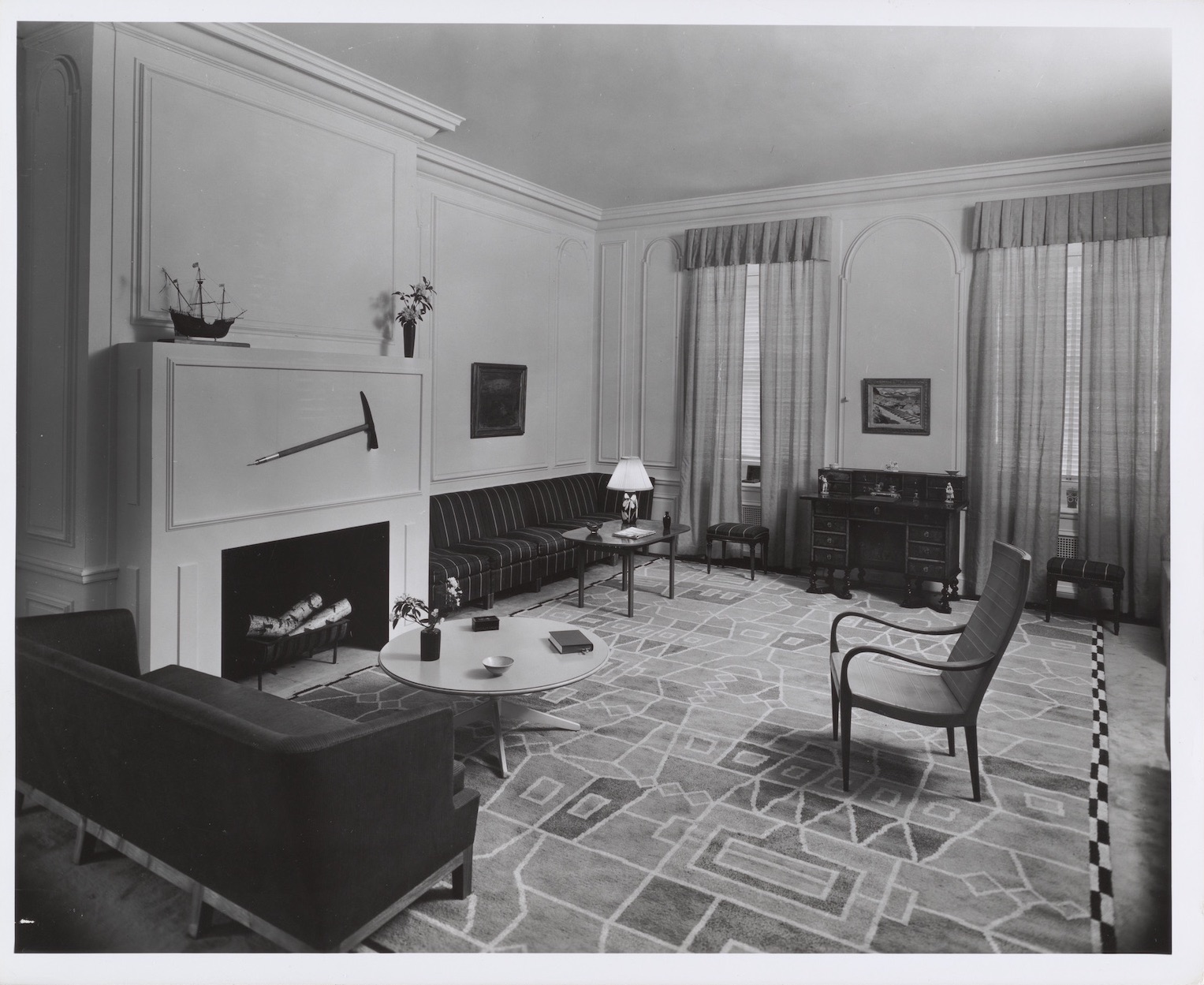
On the wall behind Hammarskjöld’s wooden desk hung a black and white panorama of the Gauri Shankar range in the Himalayas.
“Hammarskjöld took the photographs in 1960,” Karin said. “That year he was on a mission in Nepal. On the last day of his visit, the king lent him his personal plane for a courtesy flight in the Himalayas.”
“He would later publish an article in National Geographic,” she added, pointing to a copy of the magazine on a music stand.
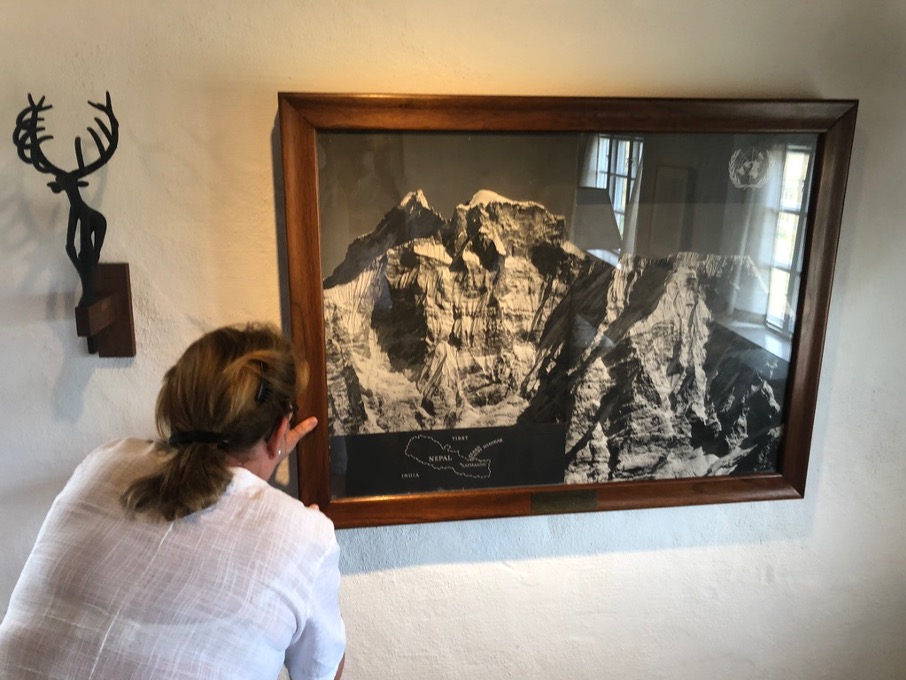
Karin and I approached the frame. She reached behind it, unlocked a hinge, and the photograph swiveled open. Behind the images, seventeen wooden rollers came to light, each tied with a white cotton ribbon. With a gentle pull of her hand, Karin untied one of them, unrolling a map of the United States.
“A map cabinet from the National Geographic Society,” she explained. “Every American president since World War II has received one of these.”
“For Hammarskjöld, they made an exception,” she continued with a note of pride.
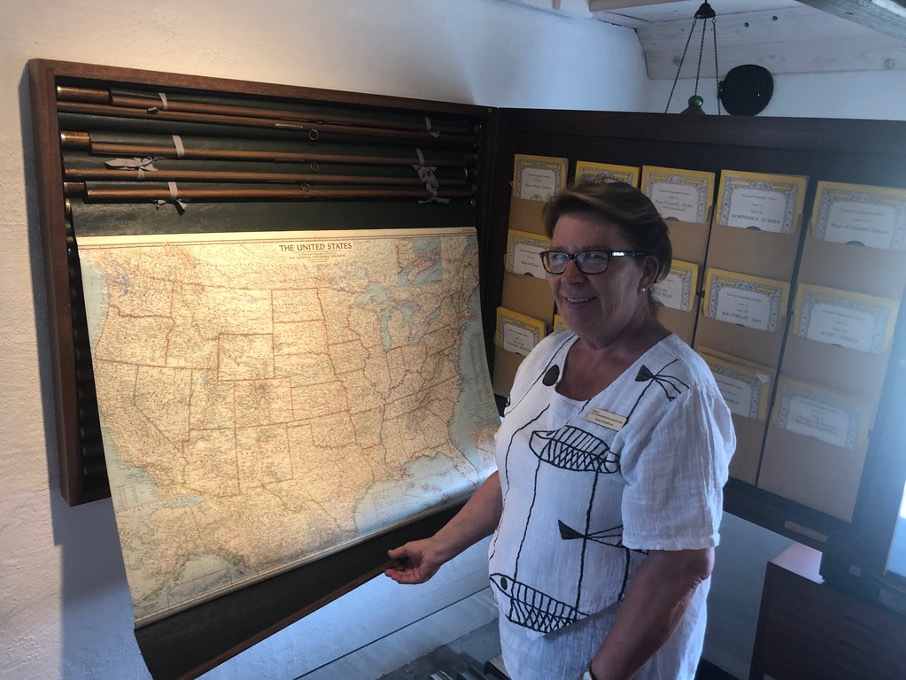
Underneath the map, I noticed a row of books placed on a low bookshelf just above the floor. Folio-sized volumes stood next to the wall, protected in a plexiglass case.
I squatted down to read the titles. There were some old acquaintances amongst them.
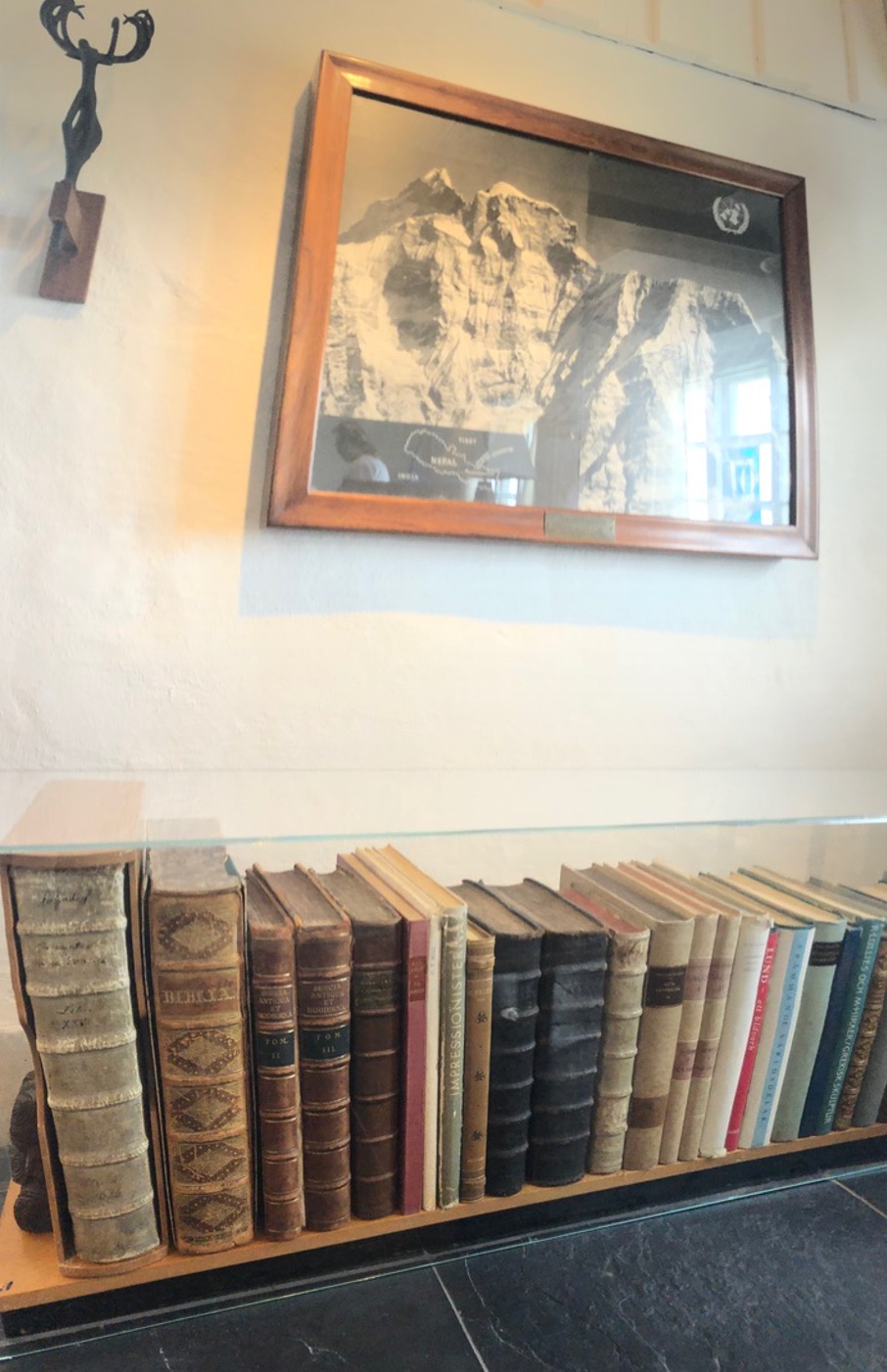
Between books on Greek art or the impressionists, I spotted Manker’s large-scale volumes on Sami drums. Further on, seventeenth-century publications on Sweden, including Erik Dahlberg’s Suecia antiqua et hodierna (“Ancient and Modern Sweden”) with its precious engravings of buildings and monuments.
Then, among the ancient prints with Latin titles, Olof Rudbeck’s Atlantica. 2 volumes.
A shock ran down my spine.
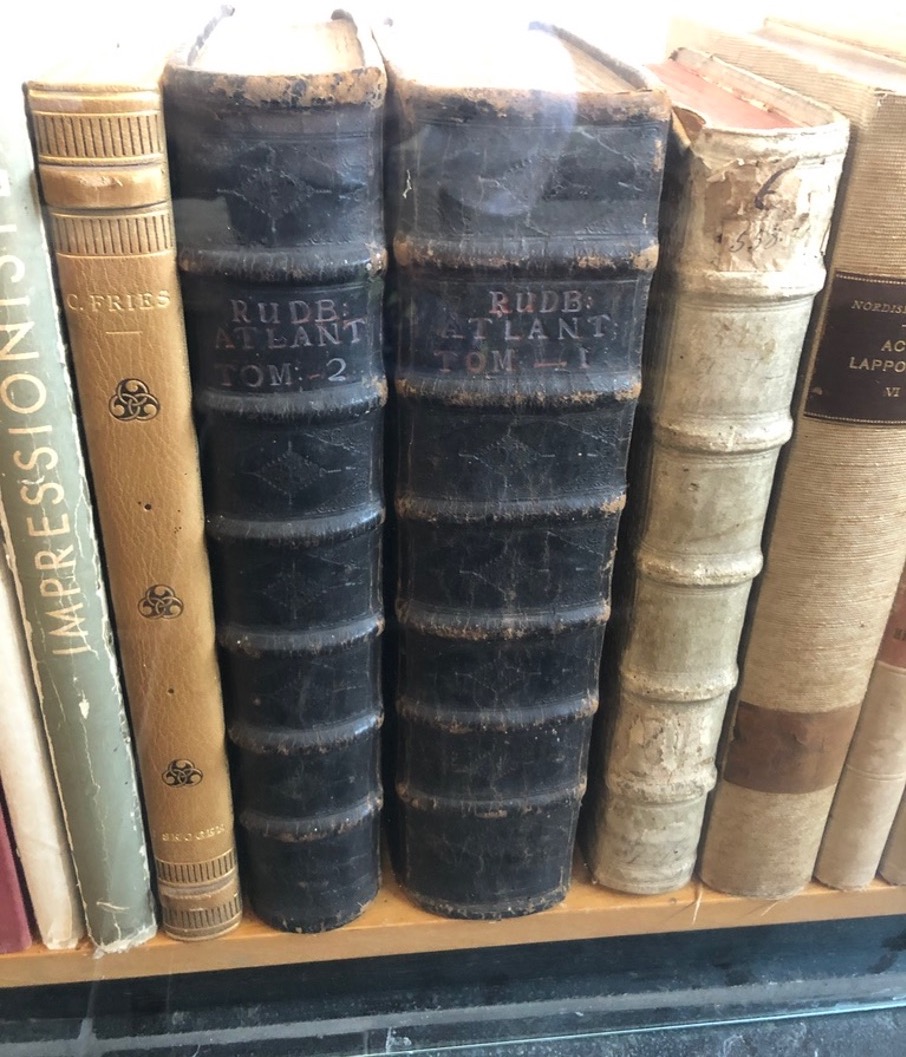
For years, I had been studying this monumental work by one of Europe’s last universal geniuses.
Olof Rudbeck, a professor of anatomy at Uppsala University, published the four volumes of Atlantica from 1679 to 1702. In them he presented ‘evidence’ that Sweden was Europe’s first high culture – the cradle of languages and the origin of classical mythology. For him and dozens who followed his ideas, the high civilization described by Plato under the name of Atlantis was, in reality, Sweden.
Libraries in Europe have been able to preserve several dozen copies of this bizarre yet fascinating work, and whenever I get the opportunity, I study them. However, no catalogue I had ever seen listed these two volumes in Hammarskjöld’s private library.
I did know that throughout his life, Hammarskjöld collected books on everything Swedish and cultivated friendships with bibliophiles such as Uno Willers, head of the Royal Library at Stockholm, who was a close friend of his.
Still, I was amazed. Earnest reader that Hammarskjöld was, I now suspected him to belong to the small readership of the Atlantica – or at least among those who could appreciate Rudbeck’s quirky scholarship enough to acquire two historic volumes of the priceless work.
I turned to Karin.
“Is there a way I could see these books,” I asked, pointing to the two volumes behind plexiglass. She thought for a moment.
“Let me talk to Claes,” she replied.
Later that day Karin’s husband and I returned to the study and carefully lifted the heavy case from the books. I picked up the two volumes and placed them on Hammarskjöld’s desk.
“You’ll be alright, won’t you?” Claes asked.
I nodded.
“And do use the chair,” he said as he returned to the entrance. I nodded again, flattered by his degree of trust.
I watched Claes return to the entrance through the hall with the wooden table.
For a while I stood alone in Hammarskjöld’s study.
My eyes wandered over Hammarskjöld’s desk and the chair behind it, over its cognac brown leather backrest, edged with brass rivets. Designed by Carl Malmsten, I later learned.
A few objects were on the desktop – a typewriter under a green protective case, a lamp, an analogue clock, a UN-flag hoisted on a miniature pole.
Among them was an item Karin had previously pointed out: a paperweight bird made of clay. “The sanningsfågel,” she had explained. ‘The Bird of Truth’.
“The surface underneath it is quite smooth,” she had said, turning the piece around. “Sometimes, Hammarskjöld’s friends said, he would turn the bird on his desk towards a guest – to make sure that he’d hear the truth.”
I took a seat in Hammarskjöld’s leather chair and arranged the two volumes before me on the desk, turning the clay bird towards them. Under the desk, my shoes sank into a soft Persian rug.
Relishing the anticipation, my fingers started to wander over the heavy leather binding. For a moment, I paused.
What will I find?, I wondered. A dedication, perhaps; bookmarks, some personal notes?
From the corner of my eye, I caught a flicker to my left. I turned my head.
A cow was swinging its tail behind a stained-glass window with Hammarskjöld’s initials.
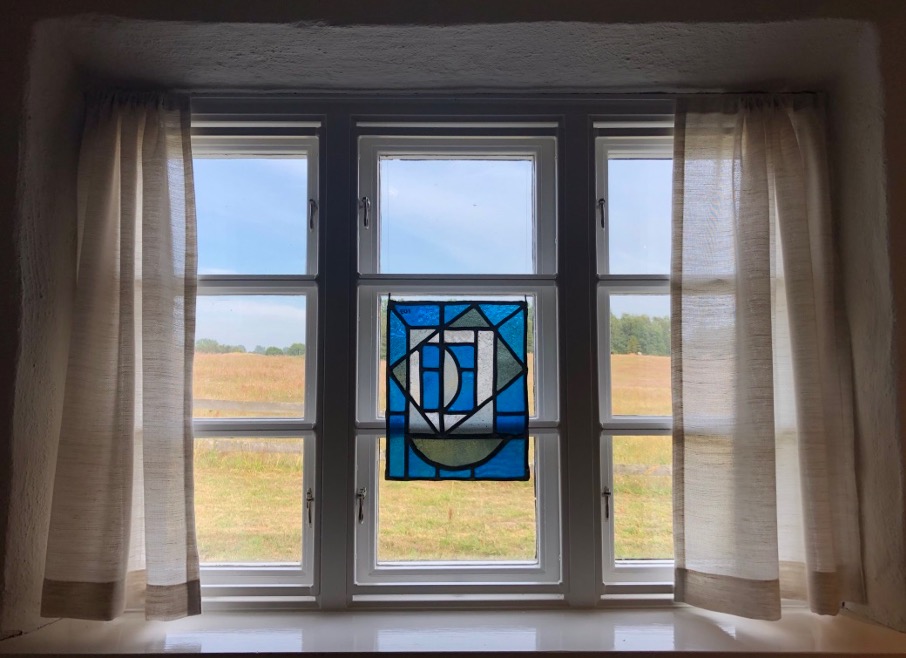
A present from his friend, the painter Bo Beskow, Karin had explained. The stained glass blurred the cow into a blob of yellow and blue as it strolled through the pasture.
My view wandered back to the uneven surface of the nineteenth-century farmhouse wall beyond the desk. It landed on an abstract painting, again by Beskow.
In 1957, Hammarskjöld invited the painter to visit him in New York. That year, the Secretary-General had a non-confessional meditation room installed in the UN headquarters.
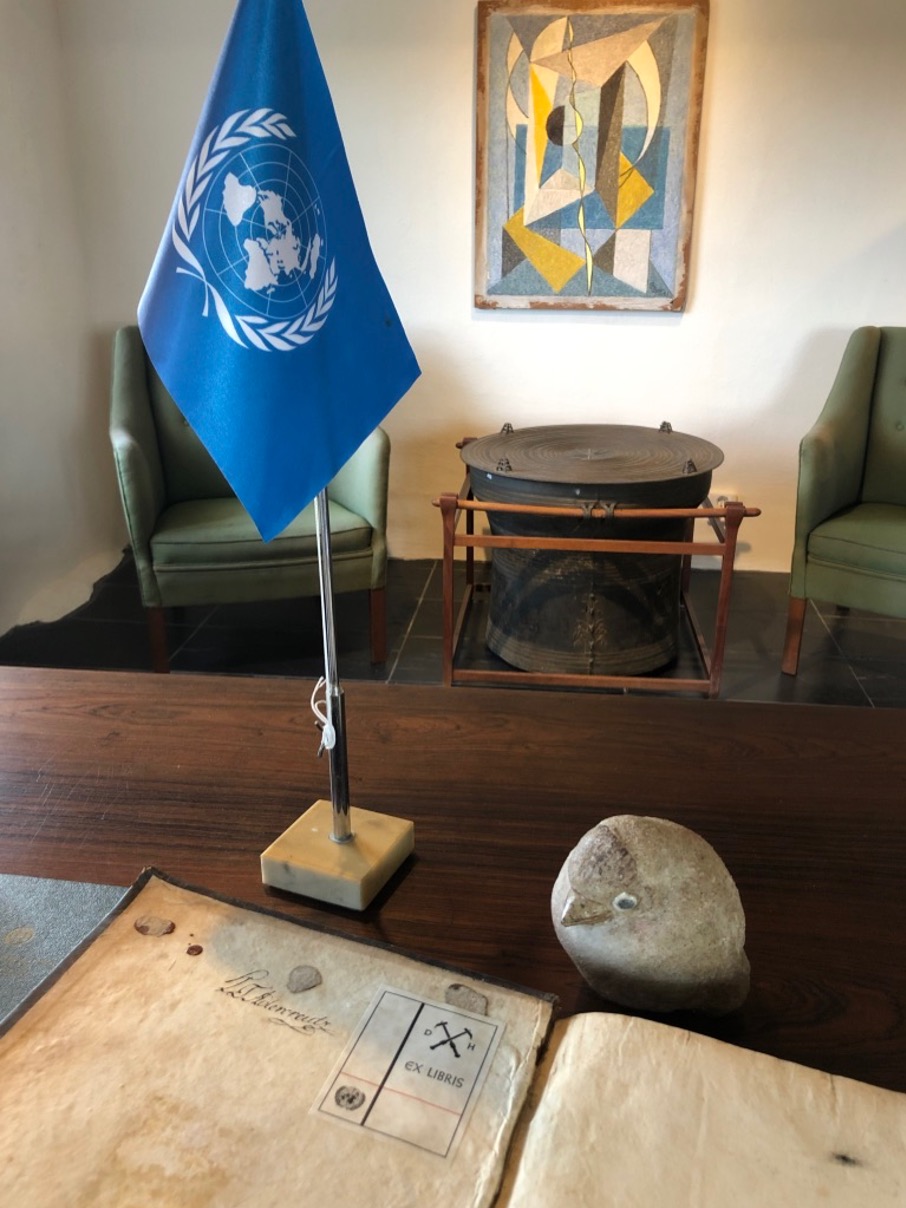
Hammarskjöld had originally asked French modernists such as Jacques Villon or Georges Braque to design the wall paintings. As Braque couldn’t travel overseas, Hammarskjöld decided to assign it to Beskow.
He and Hammarskjöld had already met in 1953, not far from here beyond the dunes, in the cottage Beskow owned at Rytterskulle. He painted Hammarskjöld’s portrait that year, when he was still working for the Swedish foreign office.
The man who captured Hammarskjöld on canvas became a close friend – perhaps the closest he ever had.
Beskow’s painting still graces the meditation room in New York. The painting I beheld across the desk was its early draft.
My gaze returned to the weighty tome in front of me. Carefully, I lifted the cover. With a slight groan, the leather binding bent. On the side of the front cover there were traces of sealing wax. The paper it once held had been removed.
In the upper right corner was Hammarskjöld’s ex libris, the paper emblem he used to mark books from his library. A pair of crossed hammers with his monogram, the UN logo below.
“Call me hammer-shield”, the diplomat used to tell journalists struggling with his name. “That’s actually what it means.”
I touched the corner of the first page. The seventeenth-century paper felt thick and heavy, made from cloth rags instead of woodchips. I began turning the pages.
The margins did contain some notes, I discovered as I browsed through the volumes. Some jottings in ink and pencil.
I was familiar with the Secretary-General’s minute handwriting, which colleagues at the UN referred to as ‘Hammarskjöld’s Arabic’. The annotations I found clearly stemmed from previous owners.
Disenchantment set in as I continued turning the pages. There didn’t seem to be any traces of Hammarskjöld himself. I flipped through the familiar volumes, through the maps and illustrations, disappointed.
Until. Until I turned that page.
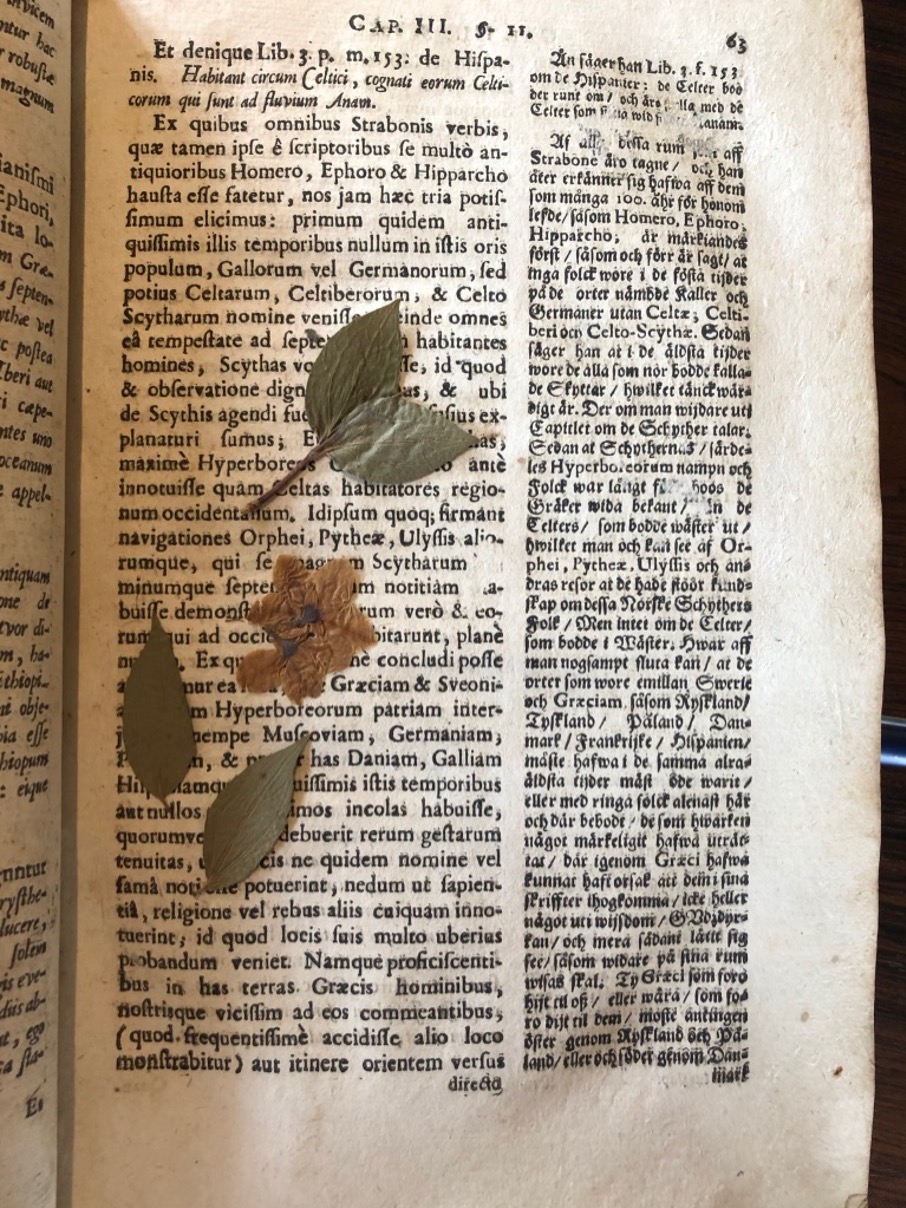
Chapter Three, “On the Time when Sweden was first Settled and by what People”. On the column of Latin words, just under the heading, lay two pressed blossoms, four leaves, and a stem. My heart missed a beat.
What if?, the thought shot through my head.
I couldn’t know if or when or where Hammarskjöld had picked the plants. I didn’t even know what I was looking at.
But as to why – after all that I had read about the man, his poetry, his love of nature, and his hope of a future home here, secluded in the nature of southern Sweden, the answer felt intuitively clear.
I leaned back in the leather chair. As I turned my head, my gaze wandered out the window again, over the pastures leading towards the sea.
Somewhere down there stood the first house Hammarskjöld bought in this area. Backåkra, where I had come, was the second.
In 1953, Hammarskjöld met Beskow for his portrait here in Österlen. He knew the landscape from cycling tours along the gentle dunes and the wild shores covered in driftwood and shipwrecks.
In the course of their sessions, Hammarskjöld had expressed how much these surroundings resonated with him. Beskow realized that his new friend was seriously looking for a place to retreat, somewhere in the green and close to the sound of the Baltic waves.
Just after Dag had started his position in NYC in 1953, Beskow wrote to him about a farmer selling a house nearby. Hammarskjöld took the opportunity and bought the old fisherman’s cottage near Hagestad.
Hammarskjöld’s tight schedule in New York allowed the diplomat to drop by only a few days each year. While he was away, Beskow oversaw the renovations of the house his friend had bought, sending regular reports and photographs.
A few weeks earlier, I had read some of the letters that are today kept in the Royal Library in Stockholm. Beskow, so I had learned on that visit to the Special Reading Room, had the wonderful habit of illustrating the letters he sent to close friends like Hammarskjöld.
In one of them, from 1954, Beskow drew the fisherman’s cottage his friend had acquired the year before. A carpet of green pours out in front of the house. In the clear sky above, a flock of birds passes over. Below, the birch trees and hedges are still bare.
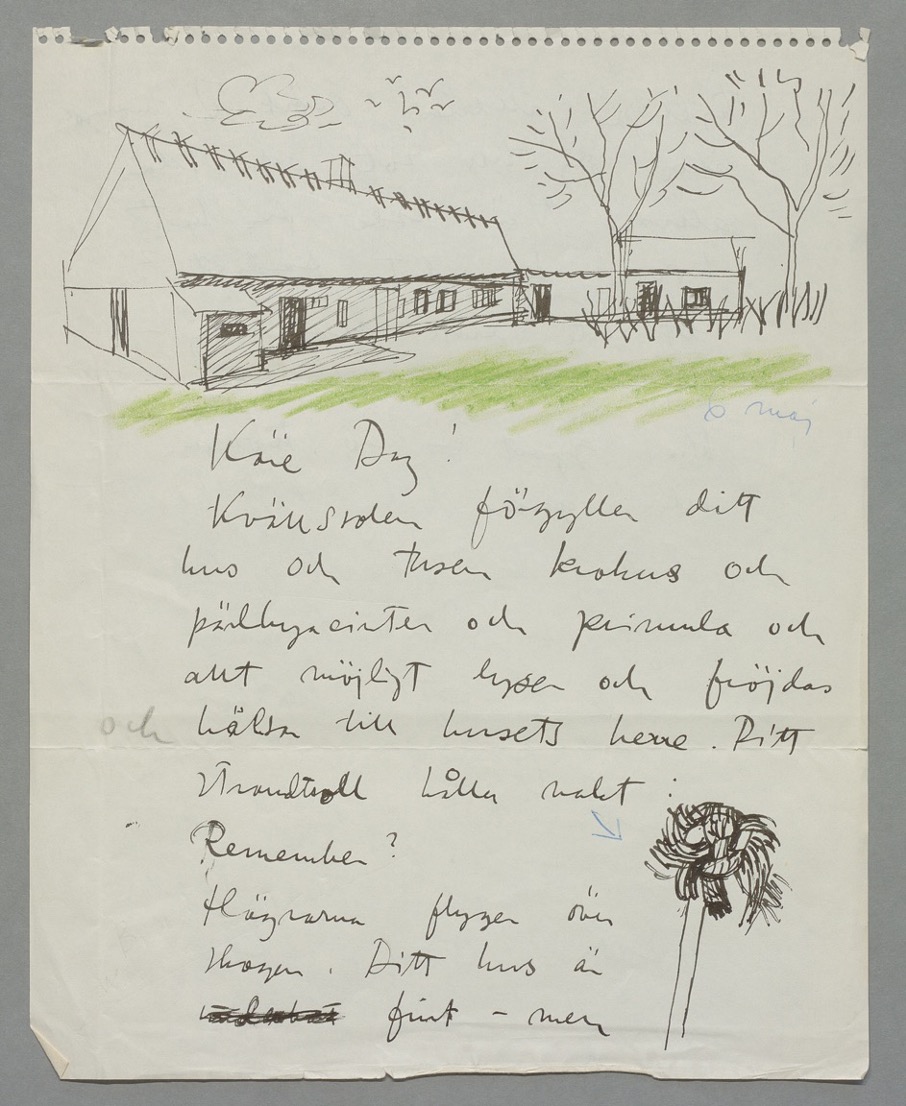
“The evening sun gilds your house,” Beskow wrote, “and thousands of crocuses and grape hyacinths and primula and all sorts of plants gleam and delight, and salute the lord of this house. Your beach troll is keeping guard.”
Then, in English: “Remember?”
Remember.
The year before, Hammarskjöld had come to Österlen for a few summer days on the coast. He spent them with Beskow watching birds, chasing butterflies, picking flowers, collecting shells and draping sea weed on driftwood, leaving behind bearded faces on the beach.
A year later, Beskow drew the first spring arriving at Hammarskjöld’s own house. His friend couldn’t be there to witness its arrival.
Hammarskjöld had become the leader of the UN when the young institution was in a deep crisis. He had a reputation as a hard-working diplomat, a self-disciplined Protestant, a somewhat aloof intellectual who kept his distance.
During his tenure as Secretary-General, the UN emerged as a protector of new democracies, becoming inconvenient to the Eastern Bloc and the West alike. Hammarskjöld’s international esteem rose quickly as he defused conflict after conflict. When the Suez Crisis began to engulf him in New York, the coasts of Österlen became as a harbor of retreat for him, serene but out of reach.
The world is slightly mad, and the more you are compelled to witness this, the more you long for good, wise friends in a quiet nook, where you don't listen to the radio and are more interested in the migrating birds (that probably by now, passing Rytterskulle, have returned to the frogs in the Nile (not minding Nasser). DAG HAMMARSKJÖLD, Letter to Bo Beskow, 15 September 1956
Behind the facade of the skilled and effective diplomat, Hammarskjöld harbored deep longings for friendship, for quiet, and for nature. The life he chose – or that chose him, as he put it – left many of those longings unsatisfied.
Throughout his adult life, Hammarskjöld gave voice to his doubts and insights in a collection of reflections and poems. The manuscript was found when friends cleared out his New York apartment after his death. Poeticised by W.H. Auden, it appeared under the title Markings in English translation (the original title was Vägmärken).
What is my role – what is our role – in all this? This is the central question running through the manuscript.
For Hammarskjöld, much of the answer revolved around perceiving human existence as part of something larger. Experiencing nature with all senses was key to the insights he tried to capture in his writing.
The language of flowers, mountains, shores, human bodies: the interplay of light and shade in a look, the aching beauty of a neckline, the grail of the white crocus on the alpine meadow in the morning sunshine –– words in a transcendental language of the senses. DAG HAMMARSKJÖLD, Markings, 1950 (p. 42)
However, there were aspects of the human experience to which Hammarskjöld remained a bystander.
Dag Hammarskjöld was never married, and we know of no significant relationships he maintained.
Beskow was one of the friends he trusted enough to address the dilemma he experienced between achieving personal happiness and following a higher calling which, all Protestant glorification aside, was intrinsic to his nature:
When I see other possibilities (like yours), I can feel a short pain of having missed something, but the final reaction is: what must be, is right. DAG HAMMARSKJÖLD, Letter to Bo Beskow, 12 November 1955
After Beskow bought his home at Rytterskulle in 1945, the cottage on the hill with its large garden had become a place of inner nourishment. For long periods during the year, he and his wife Greta retreated there from Stockholm.
When Hammarskjöld visited in the summers, he and his friend would try the herb liquors Beskow concocted from the plants in his garden, drink red wine, and talk into the wee hours about art, international affairs, or matters of the heart.
For both of them, the garden was a place to reconnect with the things that mattered to them, to perceive themselves as part of nature’s all-encompassing cycles of growth, maturity, and decay.
When the nightmares set in, I go out with a glass of sherry in the herb garden and watch as the sun rises over the hills and feel how the herbs play their organ of scents to excess. It is remarkable what a garden helps. Banal – but it's banal truths for which one sometimes must be grateful. BO BESKOW, Letter to Dag Hammarskjöld, 23 August 1953
For Hammarskjöld, the smell of plants in a friend’s garden lay out of reach for most of his time at the UN. Each visit to Österlen reminded him that here, on the other side of the Atlantic, there was a place that abounded in those things that gave sustenance to the life his calling demanded of him – close friends, nature, and literature.
I dream of private writing down at Hagestad after the five years of fighting here. Then, if ever ... DAG HAMMARSKJÖLD, Letter to Bo Beskow, Summer 1953
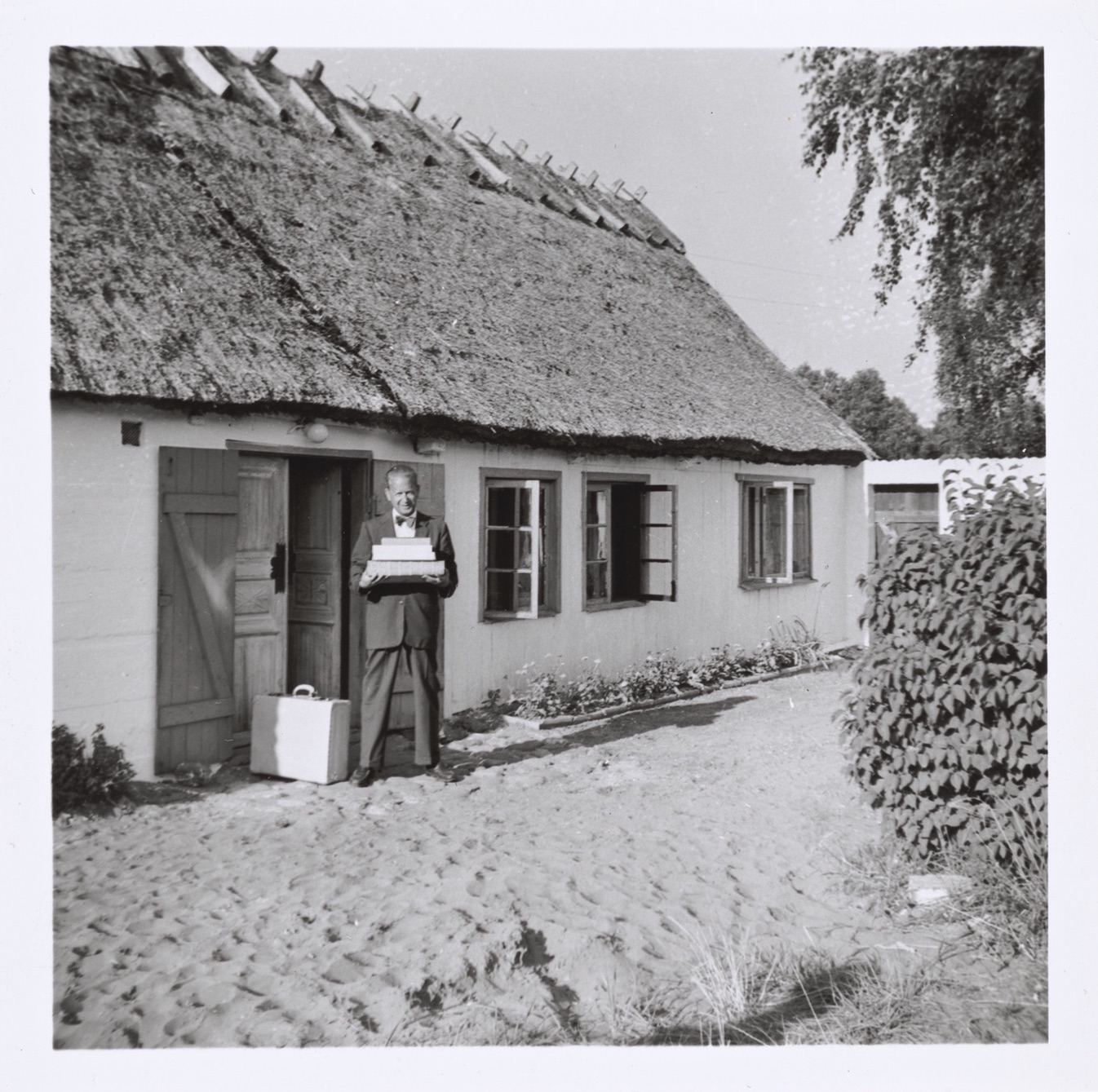
Sitting in Hammarskjöld’s leather chair, I watched the afternoon light from the windows drawing shadows on the page I had opened.
Carefully, I picked up the brittle leaves from Rudbeck’s Atlantica, turning their stem between my fingertips. Over time, the blossoms had turned a withered yellow.
All spoke of an attempt to preserve something that was not to be preserved.
Buddha had tried this too, the thought shot through my mind.
When Siddharta married, he received a palace that was surrounded by the Garden of Four Seasons. He loved the early blossoms that reminded him of the beauty of his wife. And so Siddharta gave her the room with a view of the Garden of Spring.
However, Siddharta soon had to witness its flowers wither away in the tropical climate. His joy changed to grief. The rapid decay of the sensual pleasures that plants effuse, so legend has it, led him to gather and carefully preserve flowers. Thus the tradition of pressing flowers began, in an effort to prolong their life.
Hammarskjöld was familiar with the language of flowers and seasons as manifested in Eastern traditions such as ikebana or the haiku. When his friends cleared out his NYC apartment after his death, they found a copy of Harold G. Henderson’s Introduction to Haiku among the books on the bedside table.
In 1959, Hammarskjöld had written a series of these seventeen-syllable poems. The poems recall his childhood in Uppsala, memories of collecting plants and insects around the castle where he grew up, capturing impressions of Swedish nature as it cycled through the seasons.
In the shadow of the castle
The flowers closed
Long before nightfall. DAG HAMMARSKJÖLD, Markings, 1959 (p. 178).
It seemed as if the Japanese genre, tied so closely to plants and the seasons, had gained meaning for Hammarskjöld in the last years of his life, a time when he reconnected with early memories of home and the nature he had left behind.
“Seventeen syllables,” Hammarskjöld began the 1959 cycle, “Opened the door / To memory, to meaning.”
I arched my back and considered further.
If it was Hammarskjöld who pressed these plants in his Atlantica, then this copy must have been near the place where he picked the specimens.
Reflecting on this assumption, my view wandered out of the stained-glass window with his initials, towards the horizon. From somewhere in the pasture, I heard mooing.
Then I rose from Hammarskjöld’s desk, briefly stretching my arms to the ceiling. After taking some photographs of the plants, I left the study and went in search of Karin.
“I’m sure Dag left them in there”, Karin grinned ear to ear after I had shared the find.
Patiently, she waited while I opened the local index of Hammarskjöld’s books once more.
Olof Rudbeck, Atland eller Manheim, vol. 1 and vol. 2, I read.
“Are there more detailed records of how and when Hammarskjöld would have acquired his copies of the Atlantica?” I asked Karin.
She shook her head.
It was already late in the afternoon, and the museum was preparing to close. Together with Claes, I returned to the desk once more. Carefully, we returned the Atlantica’s volumes to their plexiglass case.
I need an expert for historical plant specimens, I was already texting my librarian friend at Uppsala on the way out. From the footpath to the parking lot, I added a few snapshots I had taken to the text message.
I zoomed in on the photographs once more. The penciled note from the inside of one of the bindings once again caught my eye. In Swedish handwriting, a ‘head librarian’ pointed out that the book had been sold by the ‘University Library’.
I fired away a second message. And who could help me to hunt down former head librarians in Sweden?
Then, I looked up from the screen.
In the pastures, a few cows sunk their heads into the sun-dried grass. A bit further on, I spotted a meditation circle, placed on the site that Hammarskjöld had originally reserved for a small chapel.
Could it simply have been some flower he picked around here?, I wondered.
My view roamed across the fields. Behind the wooden fences, patches of white fluff hovered over the grass, stirred by the gentle breeze from the sea.
I don’t even know what to look for, I realized.
Back in Stockholm a few days after my visit to Backåkra, I opened my laptop. The first email replies to my query were waiting for me.
From a colleague in Gothenburg I learned that the penciled note in the Atlantica was made by a head librarian at the Helsinki National Library. It was still called University Library back then.
That head librarian had been in charge from 1934 until 1954. Hammarskjöld’s copies – or at least one of them, so it now seemed – had probably been sorted out for sale before he left for the UN.
The books may have been among the weighty historical volumes that he packed for New York, I thought. Good companions from Sweden were travelling with him.
In my mind’s eye, I could see a phalanx of staff on a bucolic airstrip near Stockholm, manhandling crates addressed for the Upper East Side. Inside, so I imagined, among other treasures, were these venerable volumes.
In the summers, Hammarskjöld returned to New York from brief visits to his beloved home country, rejuvenated from his time in the summer meadows of Österlen and the child-like joys of picking flowers, identifying plants, or chasing insects.
I remembered the atlas of butterflies that I had seen exhibited in the same glass case as the ice axe. The scrawly handwriting of an eleven-year-old pupil scrawled across the open title page.
Dag Hammarskjöld 1916, Castle, Uppsala.
Somewhat humbled, I recalled the books of flora and fauna that I had read as a child before family outings to the Swiss Alps. My taxonomic education had pretty much ended with a folder of dried tree leaves I had handed in as a sixth-grade biology project.
In Sweden, creating herbaria had a long tradition in schools. After summer vacation, children returned from all parts of the country with pressed harvests that were then presented and identified at school.
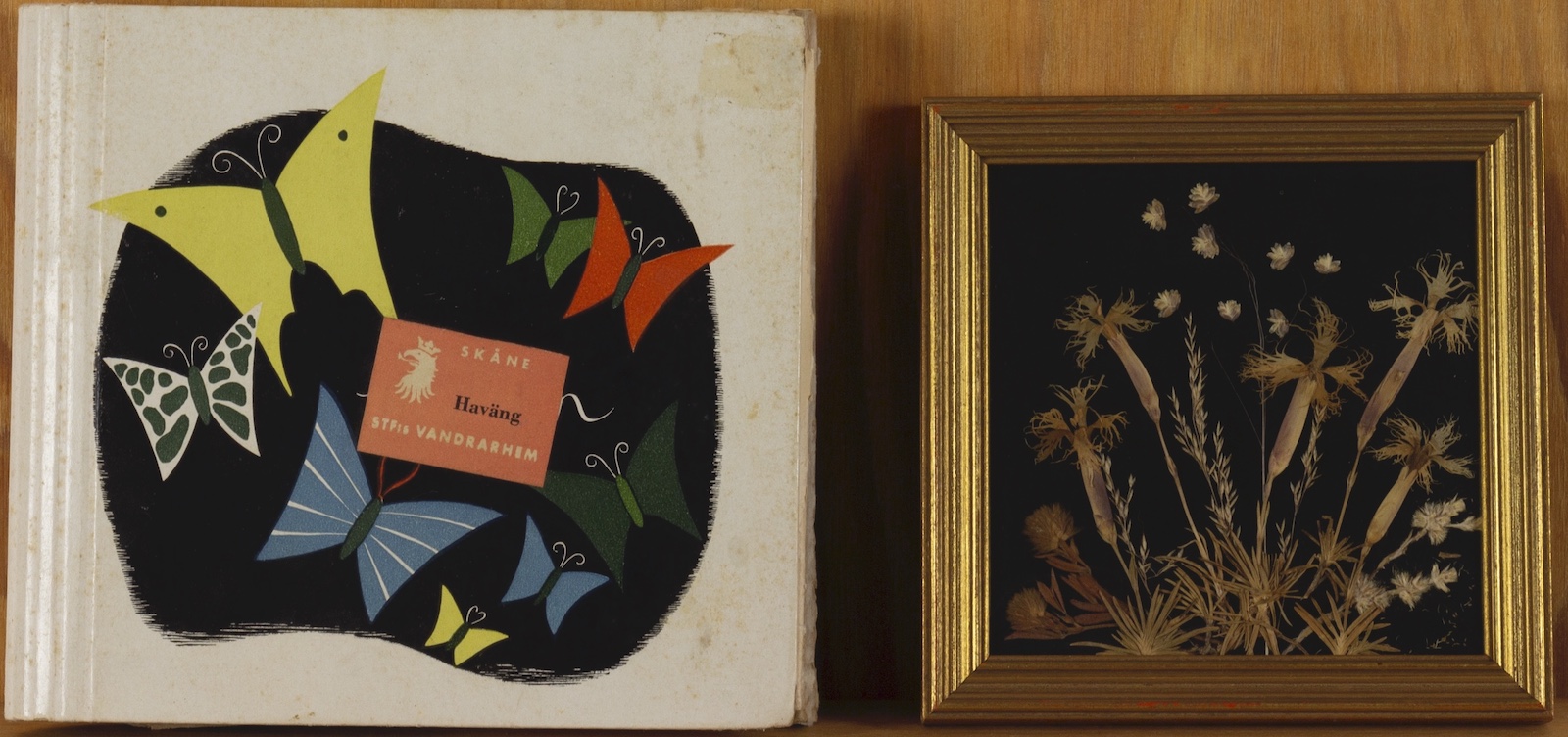
Identifying specimens of plants and insects was a hobby dear to many Swedish children. Hammarskjöld was one of them. After all, Uppsala had been the place where Carl Linnaeus had devised his System of Nature. For the eighteenth-century botanist, plants and the divine order he discerned in them were similar to what Hammarskjöld, in his poetry, called “words in a transcendental language.”
Linneaus dedicated his life to learning this hidden language of the divine. For Hammarskjöld, too, knowing nature was a spiritual path, and in this Linnaeus had been a guide. In his NYC apartment, historical editions, commemorative coins, and paintings of the “Flower King” filled a shrine-like niche.

The coins on top of his shelf stem from 1957, the year that Sweden was celebrating the 250th anniversary of Linnaeus’s birth. The same year, Hammarskjöld gave the presidential address at the annual meeting of the Swedish Academy. As a member of the committee that awards the Nobel Prize, be presented a paper “The Linnaeus Tradition and Our Time.”
Legend has it that Hammarskjöld prepared the manuscript some days before, while sitting in the UN assembly as an Indian delegate monopolized the floor with tedious monologues. And yet, the speech was a welcome opportunity to voice his deep admiration for the wonder that Linnaeus rekindled in nature; his ability to read the small print in a language that for Hammarskjöld, too, expressed the harmony in God’s creation:
As an observer and a name-giver, Linnaeus taught us to see with insight, but freely as when ‘it is ten in the morning in the head and heart.’ With the creative power of the poet, he showed us how better to capture and hold the elusive experience of the moment in the net of language. DAG HAMMARSKJÖLD, The Linnaeus Tradition and Our Time (1957)
In several of his 1959 haiku, Hammarskjöld recalls the greenery around the castle of Uppsala where he had gone on his first herbationes as a young boy, the hands-on exploration of the natural world that Linnaeus had introduced into the formal curriculum at Uppsala University.
However, since Hammarskjöld started his job at the UN, it had become increasingly difficult for him to touch the grass and smell the flowers even for a few days. In 1959, he was midway into his second term. Crises such as the one escalating in Laos only allowed for two brief visits to Backåkra that year.
While negotiations kept Hammarskjöld in distant places, Beskow pursued the plans they had for the estate, and wrote to him describing the progress. One of the letters Beskow sent late that summer opens with Linnaean plant names, along with their Swedish counterparts.
This is to inform you about some of the plants that grow on your estate, Beskow explained after a stroll through the larger property Hammarskjöld had acquired in 1957. Both were hoping to turn it into a protected area, a place that would allow future generations to read in that ‘language of flowers’.
The preliminary list of plants ends with a promising Etc.
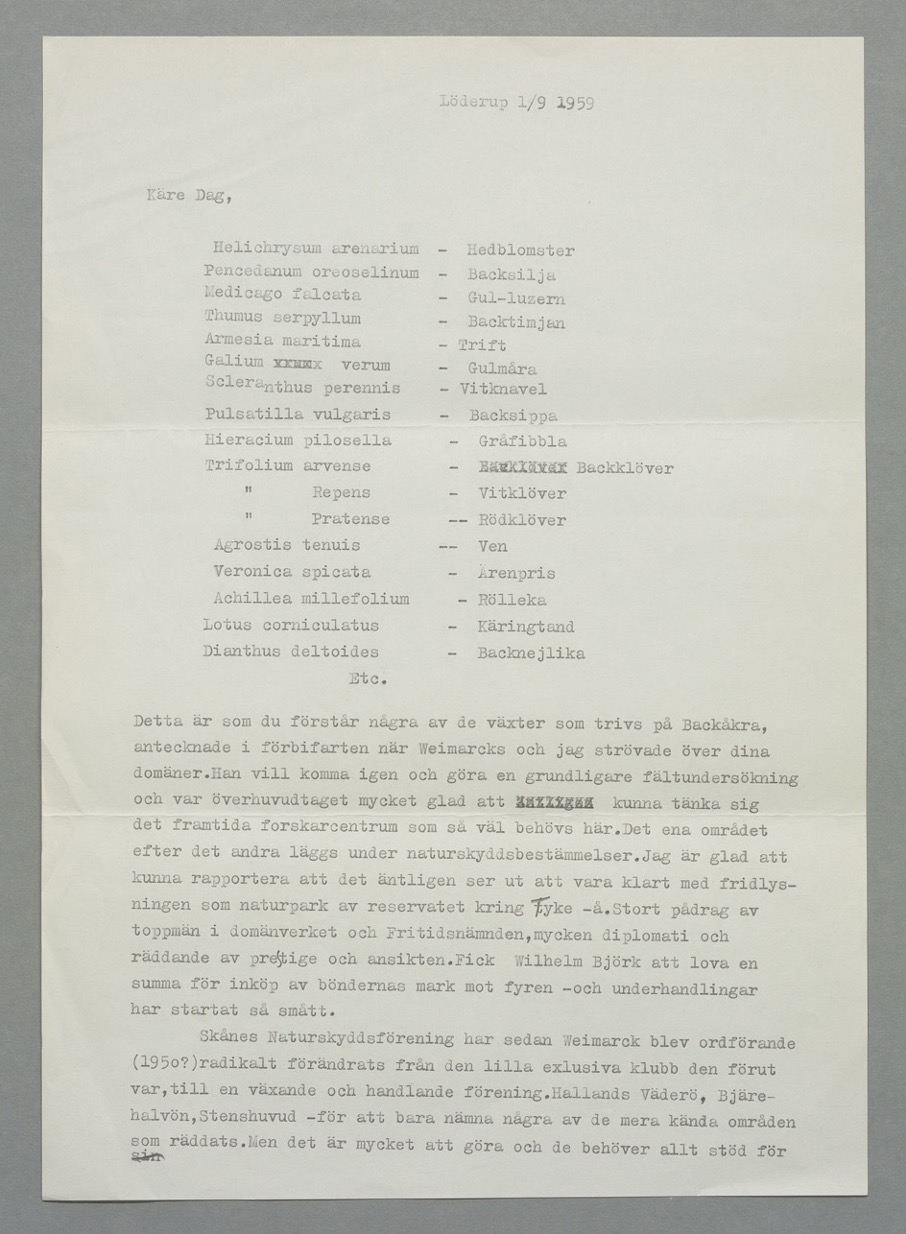
It was some days after my return from Backåkra that I received an email from Mats, an expert on historic plant material at Uppsala University. On the way to Stockholm, I had forwarded my shots from Hammarskjöld’s Atlantica to him.
Now, back at the Royal Library, I received his reply.
Seems like Philadelphus coronarius, his email opened.
Immediately, I googled Linnaeus’s Latin.
“Mock-orange.” “White pipe tree.”
I remembered spring walks in Rome and the crests of white blossoms that effused a sweet fragrance over the ruins.
I continued reading Mats’s email.
In general, it’s difficult to date historic plant specimens, he wrote. Could be a few decades, but also a few centuries.
So it was possible he picked them, I thought. I wanted the story to be true, despite all the ambiguity to which the academic in me had to admit.
There seemed no way to prove it. The specimens could have been placed in the book much earlier. I would assume that someone had checked the volumes at Helsinki Library before they were sold – and yet, it was possible that the flowers simply hadn’t been noticed.
It was irresistible to imagine how Hammarskjöld picked them, on a brief escape from his apartment on the Upper East Side, perhaps on a stroll through Central Park.
A picture started forming in my mind, of Hammarskjöld at his desk in 1961 – his last summer.
Sweden must have felt far away that evening. The year before, a humanitarian crisis had begun escalating in Africa. Three times he had already travelled to the Congo.
For Hammarskjöld, retreating to his homeland had not been an option. In New York, ceaseless political discussions on resolving the Congo Crisis followed his trips around the globe.
Perhaps it had been after one of these long debates, on the way home, where dinner guests were expected, that he had asked his driver to stop by the park. Behind the gates, the mock-orange blossoms perfumed the evening air.
Perhaps, there had been one of these “elusive experiences of the moment” as he inhaled their sweet fragrance amidst all the human folly and destruction with which he was grappling. Reassuringly, the flowers were in bloom that June, as they were every June.
The summer before, Congo had elected a government. A few months later, the Belgian forces began their withdrawal. Six decades of colonial rule had come to an end. Congo was independent.
With Western and Soviet intelligence agencies operating in the background, factions and mining companies immediately began to vie for control over the country’s rich resources.
In 1960, the new republic under President Lumumba had become a member of the UN. Now, a year later, Congo’s democratically elected head of government was dead. The troops that the UN had dispatched had failed. Despite their presence, rebel forces had captured and assassinated Lumumba.
The Blue Helmets now found themselves in violent conflict with rebel troops and mercenaries, backed by Belgian mining companies and foreign intelligence agencies.
It was a mess, to say the least.
The morning after the quick visit to Central Park, so I imagined, Hammarskjöld’s driver was already waiting to drive him back to the UN. The night had been short, and he was getting ready to return to the headquarters. His exhaustion had been increasing from day to day.
In his study, as he gathered his thoughts for the day, his glance passed over Beskow’s letters on his writing desk, and the still-fresh blossoms he had picked the night before.
A sweet fragrance lingered in the study.
He stretched his arms, his neck muscles were tense. For a while, his gaze locked on Beskow’s painting on the opposite wall.
From his wrist he heard the ticking of his watch. It was time to get going.
For a short moment, he took a seat in his leather chair. Gently, he twisted the stems in his fingers, noting the yellow pistils turn in the periphery of his vision, lost in thought.
Discouraged, his eyes rose towards the windows, the humming A/C blocking the view.
“This will be the closest I get this year,” he may have thought.
Perhaps it was then that Hammarskjöld reached behind him, towards the large volumes he kept on the floor. From the row of books, he grabbed one of the heavy Atlantica folios.
As he placed the white blossoms between its pages of learned madness, he thought of his home, where they had been printed, and its castle, the trees and flowers growing on its slopes, and his treasured childhood foraging; memories that rose for a brief moment before he closed the heavy leather cover.
Stale air escaped under the leather cover, suffused with a subtle note of citrus.
And there the flowers stayed, forgotten for six decades.
It was weeks later that Hammarskjöld got a few days of rest. Up the Hudson River at Brewster, the diplomat had a cottage where he liked to retreat with friends.
They had never seen Hammarskjöld so exhausted and gloomy as in that August, some of them later remembered. Most of the days he spent alone, they recalled, outside – writing, or listening to the birds in the hour before sunrise.
One of the poems Hammarskjöld composed during this time describes a meadow near Poughkeepsie.
A few weeks earlier, he writes, the meadow had been white with ox-eye daisies, drinking in the low light of the midsummer sun.
Here too, far away from home, nature revealed its wonders in its seamless cycle of seasons.
Seven weeks have gone by
Seven kinds of blossoms
Have been picked or mowed.
Now the leaves of the Indian corn grow broad
And its cobs make much of themselves,
Waxing fat and fertile.
Was it here,
Here, that paradise was revealed
For one brief moment
On a night in midsummer? Dag Hammarskjöld, Markings, 1961:18
For a while, I watched the wind rustling the leaves over Humlegården Park, still caught in the scene that had spun in my head. From a distance I heard the watchman’s tiny bell as he started his closing round through the Royal Library.
I was about to close my laptop and call it a day when another mail popped up in my inbox.
Despite the fact that it was the middle of the night in New York when I had written to Daniel at the Botanical Garden in Manhattan, he answered immediately.
What about Philadelphus coronarius in Central Park in the years around 1960, I had asked.
“Frederick Olmsted, one of the designers of Central Park, was fond of Philadelphus, Deutzia, Forsythia, Rhodotypus, Syringa and other profusely-flowering shrubs that would make a dramatic show, fill large spaces and withstand the volume of traffic in Central Park. These shrubs were planted early in the Park’s history and many of them have persisted to this day.”
Today, Philadelphus coronarius is blooming between late May and early June in Central Park, Daniel continued. Over the last decades, the flowers start blooming earlier each year as global temperatures increase. “The phenomenon is called phenology,” he concluded his mail. “I’m sure DH would have been interested in it.”
Dag Hammarskjöld died on 18 September 1961. His plane crashed over Central Africa as he was on the way to negotiate a cease-fire between the UN troops and Katangese rebels.
The Secretary-General’s bed from the night before was untouched. After the rest of the household and guests had left to get some brief rest, Hammarskjöld had gone out in the garden. He spent his last night outside, a close friend remembered.
There, among the trees and fragrant flowers, Dag had waited for the birds to start their morning song. ◆
Acknowledgments
For their support and feedback I have to thank Daniel Atha, Claes and Karin Erlandsson, Mika Hakkarainen, Stephen Harris, Mats Hjertson, Anders Larsson, Peter Sjökvist, Anna Svensson.
All translations and photographs are my own unless stated otherwise.
Bo Beskow tells the story of his friendship with Dag Hammarskjöld in his book Dag Hammarskjöld. Strictly Personal (Garden City 1969).
I quote Hammarskjöld's Vägmärken in the translation by Leif Sjöberg that was 'poeticised' by W.H. Auden (Markings, London 1964). The Dag Hammarskjöld Foundation has put a further edition and translation by Bernhard Erling online.
In 2018, Hammarskjöld's papers were declared part of the UNESCO Documentary Heritage. They can be consulted at the Royal Library in Stockholm (=National Library of Sweden).
So far the trace of provenance for Hammarskjöld’s Atlantica stops at Helsinki National Library. I was informed that there are no records indicating when or where the copies now at Backåkra were sold.
Today, the estate Hammarskjöld acquired at Backåkra in 1957 serves as a museum and residence for the Swedish Academy. It is open to visitors during the summer months.
As a response to the Covid pandemic, Karin Erlandsson and her daughter Kristina recently launched Dagens Dag ("Dag of the Day"). In the series they present stories behind objects from Hammarskjöld's collection and illustrate episodes from his life (you can find links to some of the clips below).
The fisherman's cottage Hammarskjöld already bought in 1953 still exists, too. It has stayed in the family's possession and lies in a secluded spot.
^ the whispers of the trees: See Dag Hammarskjöld, Markings, 1951 (p. 77).
^ The furniture is arranged identically to the original apartment: Anne Whidden has recently published a superb piece on Hammarskjöld’s NYC apartment and the rugs that artists like Edna Martin produced for him, see her article on The Swedish Rug Blog.
^ Ashanti headrest from his home country on the floor: Watch curator Karin Erlandsson introducing to the story behind the Ashanti headrest (in Swedish).
^ He would later publish an article in National Geographic: Dag Hammarskjöld, “A New Look at Everest”, National Geographic Magazine, January 1961.
^ A map cabinet from the National Geographic Society: For the tradition of the map cabinet see David Max Braun’s entry on the National Geographic Blog. Watch curator Karin Erlandsson’s introduction to Hammarskjöld’s cabinet.
^ ‘The Bird of Truth’: Watch curator Karin Erlandsson telling the story behind the sanningsfågel (in Swedish).
^ The evening sun gilds your house: National Library of Sweden, MS L 179:1:10 (letter from 6 May 1954): “Kvällssolen förgyller ditt hus och tusen krokus och pärlhyacinter och primula och allt möjligt lyser och fröjdas och hälser till husets herre. Ditt strandtroll håller vakt. Remember?”
^ The world is slightly mad: Quoted from Beskow, Dag Hammarskjöld, p. 60.
^ When I see other possibilities (like yours): Quoted from Beskow, Dag Hammarskjöld, p. 37.
^ When the nightmares set in: Stockholm, National Library of Sweden, MS L 179:1:10: “När mardrömmerna sätter åt går jag ut med ett glas sherry i kryddträdgården och ser solen gå upp over kullarna och känner örternas doftorgel spela för fullt. Det är märkvärdigt vad en trädgård hjälper. Banalt, men banala sanningar får man vara tacksam för ibland.”
^ I dream of private writing down at Hagestad: Quoted in Beskow, Dag Hammarskjöld, p. 17.
^ Buddha had tried this too: See Ida Trotzig, “On Japanese art of floral decoration”, Ethnos 2:4 (1937) 243-251.
^ Seventeen syllables: Hammarskjöld, Markings, 8.4.59 (p. 175).
^ As an observer and a name-giver: The speech is published in Servant of Peace: A Selection of the Speeches and Statements of Dag Hammarskjöld, ed. Wilder Foote (New York: Harper & Row, 1962) 151–59.
^ where he had gone on his first herbationes: The eight historical trails (herbationes) that Linnaeus started at Uppsala still exist and are described on this page of Uppsala City.
^ Could be a few decades, but also a few centuries: A few months after my visit to Backåkra, I viewed some historic specimens of Philadelphus coronarius in the collections at Oxford. The flowers stemmed from the herbarium of Robert Bobart, a seventeenth-century botanist. Bobart’s historic specimens at Oxford seemed strikingly similar to the ones I discovered in Hammarskjöld’s Atlantica.
^ the flowers start blooming earlier each year: The Royal Botanic Gardens at Kew have documented how the date of first blossoming has changed over time.
^ His plane crashed over Central Africa: Until today, the reason for the crash near Ndola in today’s Zambia remains disputed. In 2018, the UN re-opened the case. See the investigation by the journalist Susan Williams, Who Killed Hammarskjold? The UN, the Cold War and White Supremacy in Africa (2nd and rev. ed., London, 2016). In 2019, the Danish journalist Mads Brügger published his movie documentary Cold Case Hammarskjöld on the diplomat’s death.
^ He spent his last night outside: The friend who related this episode was the diplomat and philologist Sture Linnér. Hammarskjöld spent his last nights in Linnér’s villa at Leopoldville. See Beskow, Dag Hammarskjöld, p. 186.
^ UNESCO Documentary Heritage: See Ingrid Svensson’s introduction on daghammarskjold.se.